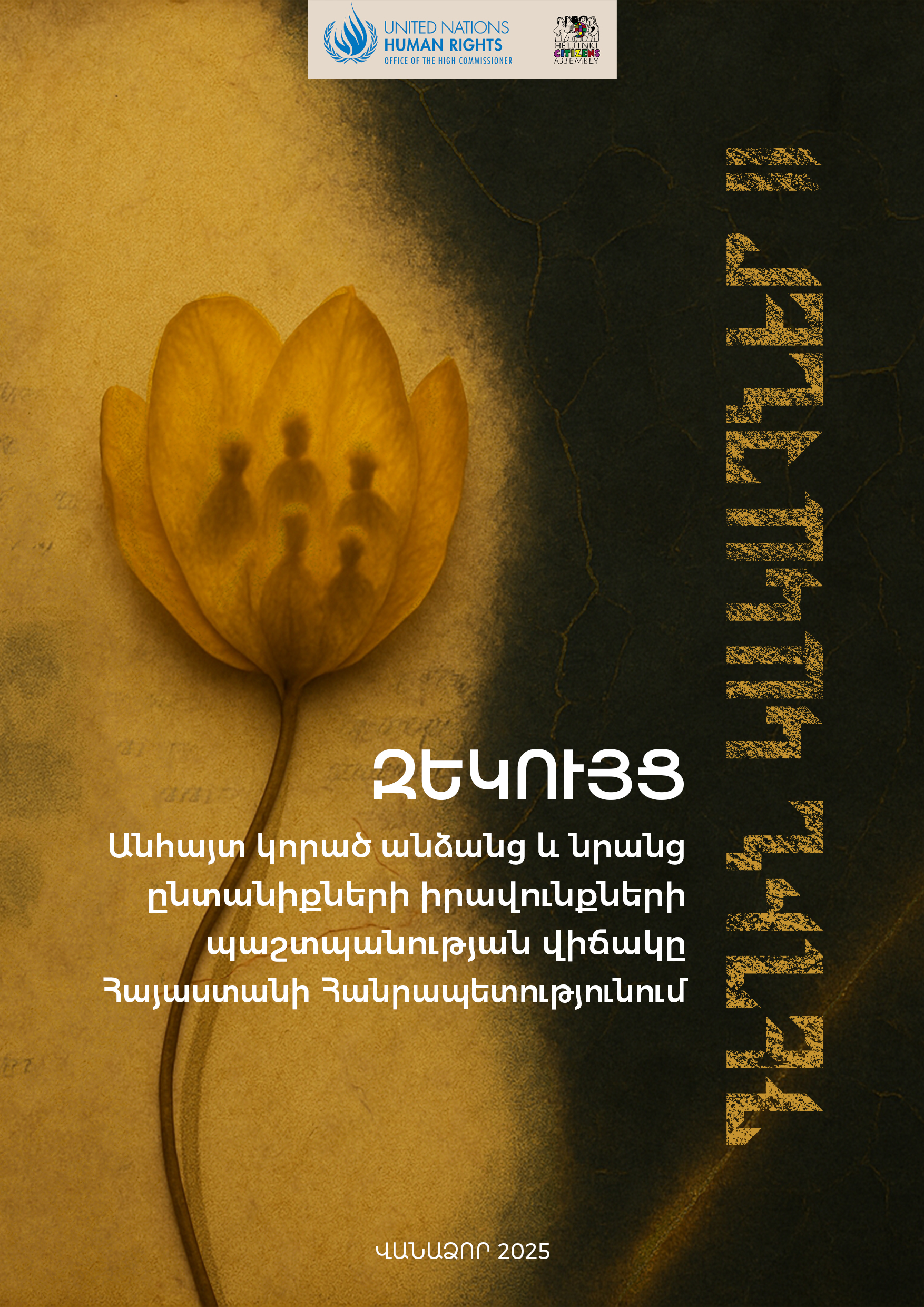This report was prepared with the financial support of the United Nations. The views, interpretations and the conclusions are those of the authors and may not align with the views of the financing organization.
More than 30 years after the first war of Nagorno Karabakh, as well as 5 years after the 44-day war unleashed by the Republic of Azerbaijan on September 27, 2020, the parents, relatives of missing servicemen are in an uncertain condition.
As a result of the Nagorno Karabakh (NK) conflict, 1160 persons are considered missing in the years 1988-2005, 437 out of which are from Armenia, 723 from Nagorno Karabakh. 224 persons out of 437 missing persons from Armenia are servicemen, 213 are civilians, and 250 persons out of 723 missing persons from NK are servicemen and 473 are civilians.
According to the data of the RA Investigative Committee, the number of missing persons after the 44-day military operations unleashed by Azerbaijan on September 27, 2020, is 195, of whom 175 are servicemen and 20 are civilians.
During the days of the 44-day of 2020, HCA-Vanadzor (hereinafter referred to as Organization) based on the fact, that RA Defence Ministry and any other state agency does not keep statistics and does not collect facts and information about the results of the missing persons as a result of the military operations, started to collect data about the persons, who had participated in the military operations and whose relatives do not have information about the fate and whereabouts of those persons. The employees of the Organization were involved in the process of answering the calls of civilians on a daily basis. The purpose of the data collection was to form a unified information database and to provide it to the RA Defence Ministry, having the aim to support the provision of information to the relatives of missing persons.
- The state does not effectively ensure the right of families of missing persons to acquire information on the fate and whereabouts of their missing persons.
- During the war operations and in the post-war period, different state agencies have performed the same powers and functions, due to which, it is not clear for the families of the missing persons to which state agency to apply for in case of various questions.
- There is no unified information management system for missing persons.
- The agencies responsible for working with the families of missing persons lack the appropriate capabilities, skills, and trained personnel.
- Information on the results confirming or denying the identification as a result of DNA sampling are not acquired in a reasonable time, the families get information on the results from different state agencies, which in turn causes unpredictability and distrust in the process.
- Investigative bodies do not provide the results of the electropherogram analysis to the relatives of the servicemen. Instead, the relatives learn about the DNA sampling results only through the expert opinion of the scientific-practical center of forensic medicine.This means that the relatives are not given the original DNA research document but rather a summarized extract.
- In some cases, investigative bodies classify as misunderstandings the situations where the DNA results of a missing person and their parent match, but subsequent verification actions through the parents show that the provided information does not correspond to reality. For example, in one case, a serviceman’s father was asked his wife’s surname, and he mentioned a different surname. As a result, the father was informed that the DNA sample of a parent with that surname matched the DNA sample of one of the deceased servicemen. This was an attempt to convince the families of the missing servicemen that the sample belonged to their missing relative and that the serviceman had died.
- The families of the missing servicemen are concerned that no numerical changes are made to the officially presented data even after proving the inaccuracies and questioning the objectivity of the DNA sample matching results. In other words, the official number of missing persons remains unchanged even when a second DNA test disproves the assumption that the serviceman is deceased. Additionally, the relatives of the missing servicemen point out that besides the officially reported 195 missing persons, the families of 85 more servicemen are convinced that despite the DNA match confirmation, the presented bodies or remains do not correspond to the physical characteristics of the missing servicemen. By considering these 85 missing servicemen as deceased, the state effectively relinquishes responsibility for their fate, ceases search efforts for their whereabouts, and presents an inaccurate picture to international bodies. Based on this, the relatives of the missing assert that the number of those missing due to the 2020 war is higher than the officially reported 195.
- The families of missing persons who have suffered the direct and immediate effects of war, have numerous needs, in particular social, legal, financial, and psychological support.
- As of April, 2025, the comprehensive law2 encompassing the rights of missing persons and their families have not been adopted in the Republic of Armenia, though in May, 2024, the Government made the commitment to adopt the law on missing persons.
- The lack of legal status for missing persons under the legislation of the Republic of Armenia forces their relatives to apply to court to recognize their relative as missing or deceased, in order to resolve certain issues in various areas, but even the aforementioned statuses do not ensure the full and complete protection of the rights and interests of missing persons and their families.
- The partial legislative solutions with the situational and non-systematic approach evidence a discretionary approach to the provision of social support, which can not be systemic, as the state’s obligation to provide social support to a family of a missing person is not established by law.
- The relatives of missing persons often encounter difficulties related to the issues of banking and inheritance, especially in situations when the person is in fact not deceased.
Report:

